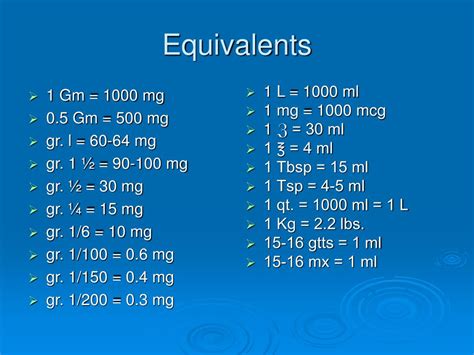How Many Milligrams Are In A Cc
Arias News
Mar 28, 2025 · 4 min read

Table of Contents
How Many Milligrams are in a CC? Understanding Units of Measurement in Medicine and Science
The question "how many milligrams are in a cc?" doesn't have a straightforward answer. It's a question that highlights a crucial point about units of measurement: you can't directly convert between milligrams (mg), a unit of mass, and cubic centimeters (cc), a unit of volume, without knowing the density of the substance involved. This article will delve into the relationship between mass and volume, explain the importance of density, and provide practical examples to illustrate this critical concept.
Understanding the Units: Milligrams (mg) and Cubic Centimeters (cc)
Let's start by defining our units:
-
Milligrams (mg): This is a unit of mass. A milligram is one-thousandth of a gram (1 mg = 0.001 g). Mass is the amount of matter in an object.
-
Cubic centimeters (cc): This is a unit of volume. A cubic centimeter is the volume of a cube with sides measuring 1 centimeter each. It's often used interchangeably with milliliters (ml), especially in medical contexts. Volume is the amount of space an object occupies.
The Crucial Role of Density
The connection between mass and volume lies in density. Density is defined as the mass per unit volume of a substance. The formula is:
Density = Mass / Volume
This formula can be rearranged to solve for mass:
Mass = Density x Volume
Therefore, to determine the number of milligrams in a cubic centimeter, you must know the density of the substance. Different substances have different densities. For example:
-
Water: At 4°C (39.2°F), the density of water is approximately 1 gram per cubic centimeter (1 g/cc) or 1000 milligrams per cubic centimeter (1000 mg/cc).
-
Alcohol: The density of alcohol varies depending on the type and concentration, but it is generally less dense than water.
-
Mercury: Mercury is significantly denser than water.
-
Air: Air has a much lower density than water.
This means that 1 cc of water contains 1000 mg of water, but 1 cc of alcohol will contain a different number of milligrams, and 1 cc of mercury will contain even more.
Practical Examples: Calculating Mass from Volume and Density
Let's work through some examples to solidify our understanding:
Example 1: Water
- Volume: 5 cc
- Density of water: 1 g/cc = 1000 mg/cc
- Mass: Mass = Density x Volume = 1000 mg/cc x 5 cc = 5000 mg
Therefore, 5 cc of water contains 5000 mg of water.
Example 2: A Hypothetical Substance
Let's say we have a substance with a density of 2 g/cc. We want to know the mass of 3 cc of this substance.
- Volume: 3 cc
- Density: 2 g/cc = 2000 mg/cc
- Mass: Mass = Density x Volume = 2000 mg/cc x 3 cc = 6000 mg
Thus, 3 cc of this substance contains 6000 mg.
Importance in Medicine and Healthcare
The relationship between milligrams, cubic centimeters, and density is critically important in medicine and healthcare. Many medications are administered based on volume (cc or ml), but their dosage is often specified in milligrams (mg). Nurses and doctors must understand the concentration of the medication (which is related to density) to ensure the correct dosage is administered. Errors in calculating dosage based on volume and concentration can have serious consequences.
Misunderstandings and Common Errors
A common mistake is to assume a direct conversion exists between milligrams and cubic centimeters. There is no such direct conversion without knowing the density. Simply stating "X milligrams are in a cc" is incorrect unless the substance is specified, and its density is known.
Another potential error is in using different units inconsistently. Remember that cubic centimeters (cc) are often interchangeable with milliliters (ml), but they are both units of volume, not mass.
Always double-check your calculations and units to avoid any errors, particularly in medical and scientific applications where precision is vital.
Beyond the Basics: Other Units and Conversions
While we've focused on milligrams and cubic centimeters, it's important to be aware of other related units:
-
Grams (g): A larger unit of mass (1000 mg = 1 g).
-
Kilograms (kg): An even larger unit of mass (1000 g = 1 kg).
-
Liters (L): A larger unit of volume (1000 ml = 1 L).
Understanding the relationships between these units is essential for accurate conversions and calculations in various scientific and practical applications.
Conclusion: Density is Key
The question of how many milligrams are in a cc highlights the fundamental importance of understanding density in the context of mass and volume. There is no single answer without knowing the density of the specific substance in question. This knowledge is critical in many fields, especially in medicine and other scientific disciplines where accurate measurements are paramount. Always remember to carefully consider the density of the substance when making conversions between mass and volume. Failing to do so can lead to errors with serious consequences. Thorough understanding of units and their interrelationships is crucial for accurate scientific and medical practices.
Latest Posts
Latest Posts
-
How Long Would It Take To Get To Orlando Florida
Mar 31, 2025
-
Double Cup Love You The One I Lean On
Mar 31, 2025
-
What Is 20 Percent Of 20 Dollars
Mar 31, 2025
-
1 1 2 4 3 9 4
Mar 31, 2025
-
Why Does Gatorade Taste Salty Sometimes And Sweet Other Times
Mar 31, 2025
Related Post
Thank you for visiting our website which covers about How Many Milligrams Are In A Cc . We hope the information provided has been useful to you. Feel free to contact us if you have any questions or need further assistance. See you next time and don't miss to bookmark.
